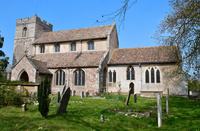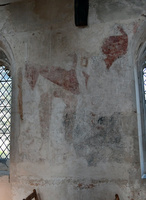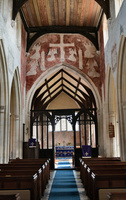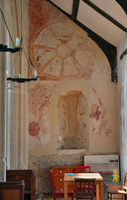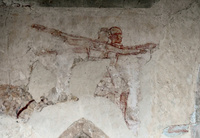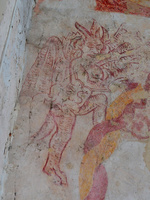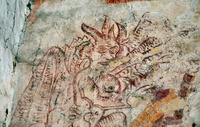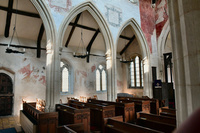Yesterday's target, and the reason I cycled 50 miles, was this place: the Church of All Saints and Saint Andrew in Cambridgeshire. I liked the sound of it for three reasons: 1, the silly name (why add St Andrew when you'd already covered everything with All Saints?), 2, I'd seen a photo and it looked very pretty and 3, I'd heard it has some interesting late medieval wall paintings inside.
There seems to have been a church here at the end of the 13th Century, probably Norman but perhaps Saxon, but nobody knows what happened to it other than that it was replaced by a new building in about 1352: there are a few bits of masonry from the older church set into the walls of the current church. The first thing that gets noticed is the nave, which is almost as tall as the tower (the tower, admittedly, isn't very tall) and not far off twice as tall as the chancel, which makes it look like it might have second storey inside. It hasn't, of course, and the original nave was probably much shorter - but it burned down in 1448 and then, because the tower was leaning on it, that collapsed too. Fortunately, the parish had by that time been given to King's in Cambridge by the college's founder Henry VI and thus had a powerful and wealthy new backer; however, despite the fact that the parish was of considerably more importance back then, when it was one of the most populated in its hundred and had a weekly market and two annual fairs, it took 40 years before anyone got around to stumping up the funds for repairs. Presumably, when they eventually got their hands on the cash, the parish elders decided they might as well have as tall a nave as they could get. The medieval period is usually considered to have ended in 1500; these paintings are, therefore, very late medieval and could even be considered to date from the transitional period between the medieval and the early modern era.
More and more wall paintings are being discovered and preserved in churches nowadays, but these are spectacular for the expressiveness and variety. There is a badly faded St George on horseback, thrusting his lance into the mouth of a dragon that could have been drawn by a five-year-old; the saint, horse and dragon are too faded to make out any detail but the horse's bridle is well-preserved, suggesting a different sort of paint was used to depict it. Nearby is St Christopher, whose lower legs and staff are visible as he prepares to walk into or steps out of the river, but his upper body and the child Christ he carries have disappeared.
On the chancel arch, where there'd more commonly be a Doom, is a Crucifixion. The space has been painted red, which is faded now but may once have been vibrant. In the centre is an unpainted area shaped like a cross with a hump on the lower right side where Christ's knees would have been and, invisible to the naked eye (well, my eyes at any rate) but obvious by zooming into a photo, what could be holes left by nails hammered into the stonework; either side there are two more unpainted patches extending upwards from broken stone ledges – which all suggests that the the three spaces are unpainted because they were once filled with statues. Though still amateur, whoever painted this one had far greater skills than the artist(s) of most of the other works in the church – the overall composition and the wings of the angels either side of the cross show some aptitude (it's notable that the reverse of the angels' wings are black – perhaps the same paint as the horse's bridle, and perhaps it was not originally black but has changed colour with time? I also wonder if there's a sun or moon top left of the cross and, just perhaps, a hint of a pattern behind the main central section and the left-hand section beyond the chancel arch/nave wall corner... only permission, a ladder and greater expertise than I possess in this field would tell.
I especially like the two knights, one with a broken nose and the other with a fine Roman nose; they're throwing spears, but it looks a little like they're enjoying a romantic dance together. There is also a seven-spoked wheel, presumably symbolising the Seven Corporeal Acts of Mercy, being turned by angels, and a tree (of the knowledge of good and evil?) below it.
The best by far, though, is a little further down the wall from the seven-spoked wheel, by the top left corner of a niche – a devil climbing up a rope. He has hooves, horns and bat-like wings, but isn't very scary at all – nor is he very well-drawn, which makes him even better because he looks exactly like he's been doodled with a red ballpoint pen in the margin of a newspaper by somebody pondering a devilish crossword clue. There are traces of another rope on the other side of the niche and there might have been another devil there; if so, it's long gone.
The paintings were discovered in the late 19th Century and came immediately to the attention of the great medieval wall painting expert and conservator Ernest William Tristram, who recommended they be protected by a layer of clear wax. Unfortunately, he was quite wrong in that: lime render traps moisture during humid weather and must be permitted to release it back into the air, his attempts to preserve the paintings at Kingston are quite likely, therefore, to have caused more damage to them than the layer of whitewash that was applied to cover them up. In the 1980s they were discovered to be in grave danger of being lost forever; however, using techniques that were not available to Tristram, conservators were able to stabilise them and partially restore some sections.

Enjoy being online again!
Welcome to the community of good people who base their values on evidence and appreciate civil discourse - the social network you will enjoy.Create your free account
14 comments
Feel free to reply to any comment by clicking the "Reply" button.Love this. Thank you so much for sharing.
I love wall paintings. We lost so much when the Puritans painted then out. You realise how amazing they can be when you see them in places like Russia where the churches still have lots of early ones.
Jnei:
"Basher" Dowsing paid a visit to that church, along with most of the others in Cambridgeshire and Suffolk - there are a row of little carved heads up in the roof, all with their faces smashed. He did an incredible amount of damage in a short space of time.
Sounds like a great ride. Thanks for sharing your photos and history of the area.
Ever thought of being an historical novelist? -- not a far leap considering the background detail you are able to gather from one visit. I have an analogy to the All Saints Plus One concept -- something like All Spice + Paprika (?) The extra one, though doubled-up on, might give it an emphasis or special lift.
Enjoy being online again!
Welcome to the community of good people who base their values on evidence and appreciate civil discourse - the social network you will enjoy.Create your free account
Share this post
Categories
Agnostic does not evaluate or guarantee the accuracy of any content. Read full disclaimer.
